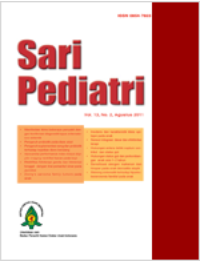Penggunaan Antibiotik Khususnya pada Infeksi Bakteri Gram Negatif di ICU Anak RSAB Harapan Kita
Sari
Pendahuluan. Rumah sakit dan unit perawatan intensif (ICU) merupakan breeding
ground atau tempat berkembangnya bakteri. Strategi pemberian antibiotik yang terbaik
adalah dengan membatasi penggunaan antibiotik yang tidak terindikasi dan mengurangi
lama penggunaan antibiotik.
Tujuan. Tujuan penelitian ini adalah mengevaluasi penggunaan antibiotik pada infeksi
bakteri Gram negatif, mencakup latar belakang diagnosis klinis dan lama penggunaan
antibiotik.
Metoda. Metode penelitian retrospektif – deskriptif selama periode satu tahun antara
Oktober 2001 hingga September 2002. Penelitian dilakukan di ICU Anak RSAB Harapan
Kita Jakarta. Hubungan bakteri Gram negatif dan antibiotik akan ditampilkan dalam
grafik Pearson correlation. Risiko relatif (RR) untuk mengetahui 1) Lama terapi
cefotaxime mempengaruhi timbulnya resistensi cefotaxime 2) Lama perawatan akan
mempengaruhi timbulnya resistensi.
Hasil. Dari semua kelompok umur ditemukan 49 pasien ( 52,7%) dicurigai pneumonia,
15 pasien ( 16,1%) dengan sepsis, 7 pasien ( 7,5%) dengan infeksi saluran kencing, 35
pasien ( 37,6%) dengan gastroenteritis dan 12 pasien ( 12,9%) dengan bakteremia.
Pada grafik Pearson correlation menunjukkan pada pemakaian sulbactam ampicillin
yang makin lama, maka resistensi bakteri Gram negatif terhadap antibiotik ini makin
tinggi. Hal yang sama juga terjadi pada pemakaian antibiotik ampicillin dan amikacin.
Perawatan inap yang memanjang juga akan meningkatkan resistensi bakteri Gram negatif
( P.aeruginosa dan Enterobacter sp) terhadap cefotaxime dengan RR >1.
Kesimpulan. Patogen yang paling utama adalah E.coli, Pseudomonas sp, Klebsiella sp
dan Enterobacter sp, dua patogen yang terakhir adalah yang paling dominan dari extented
spectrum β lactamases producing-enterobacteriaceae (ESBLPE).
Kata Kunci
Teks Lengkap:
PDFReferensi
Georgopapadakou NH. Antibiotic resistance in enterobacteria.
Dalam: Lewis K, Salyers AA, Taber HW, Wax RG,
penyunting. Bacterial resistance to antimicrobials. Edisi
Kesepuluh. New York: Marcel Dekker,2002. h.405-26.
Athale UH, Brown RC, Furman WL. Immunomodulation.
Dalam: Patrick CC, penyunting. Clinical
management of infections in immunocompromised infants
and children. Edisi pertama. Philadelphia.
Lippincott Williams & Wilkins, 2001. h.584-615.
Long SS, Dowell SF. Anti-infective therapy. Dalam:
Long SS, Pickering LK, Prober CG, penyunting. Principles
and practice of pediatric infectious diseases. Edisi
kedua. Philadelphia: Churchill Livingstone,2003.
h.1422-32.
Toltzis P, Yamashita T, Vilt L, Blumer JL. Colonozation
with antibiotic-resistant gram-negative organisms in a
pediatric intensive care unit. Crit Care Med 1997;
;538-44.
Al-Lawati AM, Crouch ND, Elhag KM. Antibiotic consumption
and the development of resistance among
gram-negative bacilli in intensive care units in Oman.
Annals of Saudi Med 2000; 20:325-7.
Garcia-Rodriguez JA, Jones RN. Antimicrobial resistance
in gram-negative isolates from European Intensive Care
Units: data from the meropenem yearly susceptibility
test information collection (MYSTIC) programme. J
Chemotherapy 2002; 14:25-32.
Lewis LL, Pizzo PA. Infections in the hospitalized and
immunoincompetent child. Dalam: Katz SL, Gershon
AA, Hotez PJ, penyunting. Krugman’s infectious diseases
of children, Edisi kesepuluh. Philadelphia:
Mosby,1998. h. 213-35.
Waterer GW, Wunderink RG. Increasing threat of Gramnegative
bacteria. Crit Care Med 2001; 29:N75-81.
Garna H. Hospital stay in nosocomial infections.
Paediatr Indones 1993; 33:142-9.
Rahal JJ, Urban C, Horn D, et al. Class restriction of
cephalosporin use to control total cephalosporin resistance
in nosocomial Klebsiella. JAMA 1998; 280:1233-7.
Humphreys H. Respiratory infections. Dalam:
Humphreys H, Willatts S, Vincent J-L, penyunting.
Intensive care infections, Edisi pertama. London. 2000.
h. 87-103.
Goldmann DA, Weinstein RA, Wenzel RP. . Consensus
statement: strategies to prevent and control the emergence
and spread of antimicrobial-resistant microorganisms
in hospitals, a challenge to hospital leadership.
JAMA 1996; 275:234-40.
Gerding DN, Larson TA, Hughes RA. Aminoglycoside
resistance and aminoglycoside usage: ten years of experience
in one hospital. Antimicrobial agents and chemotherapy
; 35:1284-9.
Carlet J. Antibiotic management of severe infections in
critically ill patients. Dalam: Dhainaut J-F, penyunting.
Thijs LG, Park G. Septic Shock. Edisi pertama. London.
WB Saunders, 2000. h. 445-60.
Itzhak L, Leonard L, Moshe D, Zmira S, Hana K, Shai
A. A prospective study of gram negative bacteremia in
children. Pediatr Infect Dis J 1996; 15:117-22.
Gruson D, Hilbert G, Vargas F. Rotation and restricted
use of antibiotics in a medical intensive care unit.: impact
on the incidence of ventilator-associated pneumonia
caused by antibiotic-resistant gram-negative bacteria. Am
J Respir Crit Care Med 2000; 162:837-43.
Roder BL, Nielsen SL, Magnussen P, Engquist A,
Frimodt-Moller. Antibiotic usage in an intensive care
unit in a Danish university hospital. Journal of Antimicrobial
Chemotherapy 1993; 32:633-42.
Kollef MH, Sherman G, Ward S, Fraser VJ. Inadequate
antimicrobial treatment of infections: a risk factor for
hospital mortality among critically ill patients. Chest
; 115:462-73.
DOI: http://dx.doi.org/10.14238/sp8.2.2006.127-34
Refbacks
- Saat ini tidak ada refbacks.
##submission.copyrightStatement##
##submission.license.cc.by-nc-sa4.footer##
Email: editorial [at] saripediatri.org


Sari Pediatri diterbitkan oleh Badan Penerbit Ikatan Dokter Anak Indonesia
Ciptaan disebarluaskan di bawah Lisensi Creative Commons Atribusi-NonKomersial-BerbagiSerupa 4.0 Internasional.




